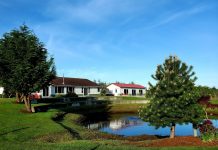
Regenerative medicine itself is not a new concept. Organ and bone marrow transplants have saved lives for decades. Today, however, researchers have discovered how to harness the body’s own healing process and accelerate it in targeted areas of need. The field of regenerative medicine has the potential to heal damaged tissue.

The physicians at Olympia Orthopaedic Associates are on the cutting edge of this medical technology. PRP, or Platelet Rich Plasma, injections are now available to patients in the Sports Medicine Clinic at OOA. A patient has his or her own blood drawn in the clinic. The blood is then placed in a centrifuge, a machine that rapidly spins the blood to separate it into plasma, white blood cells and red blood cells. Separating the contents allows collection of a more concentrated portion of the blood that is responsible for tissue repair and healing. The resulting concentrate is then injected into the desired site. This injection boosts the body’s own ability to heal.
Physicians at OOA, Dr. Tracy Hamblin and Dr. Dominic Femiano are using this technology in the sports medicine clinic to treat both acute and chronic injuries. “When an injury is chronic and has been going on for some time, the body stops creating an inflammatory response,” explains Dr. Hamblin. “The injection will remind the body to heal this area.” It may also aid in speeding up the healing process in more acute injuries.

There are very minimal risks similar to a cortisone injection. Since the patient is using his or her own blood, there is virtually no risk of rejection as happens in other regenerative techniques such as bone marrow and organ transplants. Some initial pain and swelling can be expected as the intent is to trigger the body’s natural healing inflammatory response with the PRP. Under an hour, in one appointment, a patient has their blood drawn, the blood is prepared and the PRP is injected. They can then carry on with their normal day.
Most patients report decreased pain and increased mobility within three months of receiving the PRP injection. For a youth baseball player experiencing the injury of Tommy Johns syndrome or an athlete with tennis elbow, this treatment can be life changing.
“We are seeing that patients with osteoarthritis will benefit from PRP injections in terms of decreased pain,” says Dr. Hamblin. She notes that there is no current evidence that there is actual cartilage regeneration following the PRP injection. Osteoarthritis is a degenerative joint disease that affects over 20 million people in the US. “We think PRP will be more beneficial to patients with moderate osteoarthritis as opposed to treating severe cases,” she continues. “It is our hope that PRP injections and the growing field of regenerative medicine can help us to retain mobility and age with reduced or eliminated pain.”

Insurance companies vary on their coverage and the staff at OOA can help you determine your benefit. Over time, Hamblin expects more companies will cover this treatment if the studies continue to show benefit. The injection can save money over a period of time by decreasing the use of pain medications and potentially eliminating the need for an expensive and more invasive surgery.
There are further ground breaking treatments offered at OOA. Persistent tendon pain that is not responsive to PRP or other conservative treatments may benefit from Tenex. Tenex is a percutaneous tenotomy, a minimally invasive treatment for chronic tendon pain which increases blood flow and healing to a desired area. The ideal patient has persistent pain in his or her shoulder, elbow, knee, Achilles tendon or plantar fascia. As Dr. Hamblin explains, “The Tenex technology is designed to break up scar tissue and remove it while leaving the healthy tissue in place.” Drs. Hamblin and Femiano have done over thirty cases of the Tenex procedure with an 80% success rate. For those who have struggled with plantar fasciitis this is exciting news.

There are even more options for healing on the horizon at Olympia Orthopaedic Associates. Dr. Hamblin hopes to be offering stem cell injections within six months. Cells will be retrieved from the patient’s own body, eliminating any chance of rejection and lowering infection risk.
Olympia Orthopaedic Associates have many tools at their disposal to help patients of all ages from athletes completing Ironman triathlons to power walkers. The reassuring thing about visiting the sports medicine clinic at OOA is having access to every option from physical therapy and minimally invasive treatments to surgical options if necessary. Drs. Hamblin and Femiano want to keep you moving.
You can hear more about PRP injections from Drs. Femiano and Hamblin themselves at an upcoming Sports Medicine Seminar on March 15 at 5:30 p.m. at the OOA Westside Clinic. For questions or to RSVP, call Rachel Sherburne at 360-570-4862.
For more information on PRP Injections and other healing options available at Olympia Orthopaedic Associates visit their website at http://www.olyortho.com or call them at 360-709-6230.











































